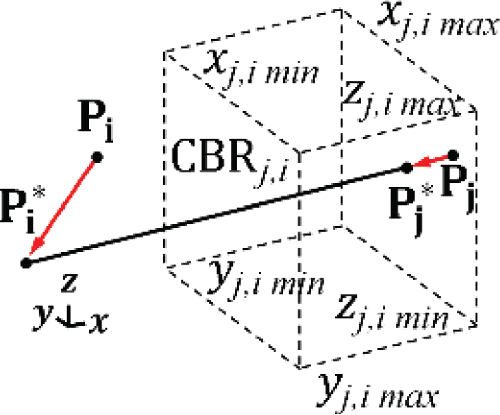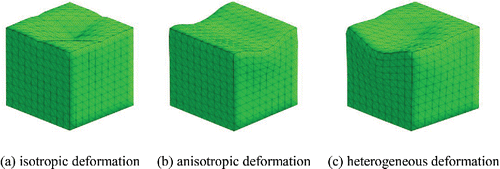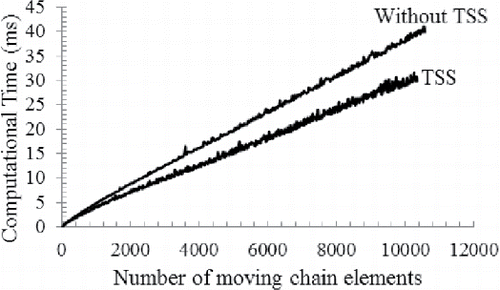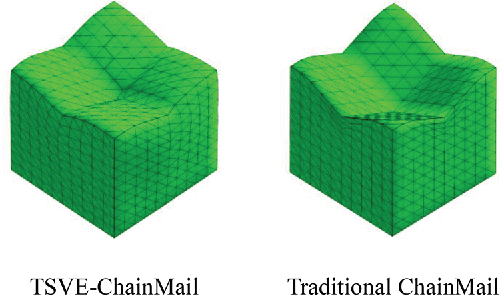 ?Mathematical formulae have been encoded as MathML and are displayed in this HTML version using MathJax in order to improve their display. Uncheck the box to turn MathJax off. This feature requires Javascript. Click on a formula to zoom.
?Mathematical formulae have been encoded as MathML and are displayed in this HTML version using MathJax in order to improve their display. Uncheck the box to turn MathJax off. This feature requires Javascript. Click on a formula to zoom.ABSTRACT
This paper presents a new ChainMail method for real-time soft tissue simulation. This method enables the use of different material properties for chain elements to accommodate various materials. Based on the ChainMail bounding region, a new time-saving scheme is developed to improve computational efficiency for isotropic materials. The proposed method also conserves volume and strain energy. Experimental results demonstrate that the proposed ChainMail method can not only accommodate isotropic, anisotropic and heterogeneous materials but also model incompressibility and relaxation behaviors of soft tissues. Further, the proposed method can achieve real-time computational performance.
Introduction
Soft tissue simulation is a challenging research topic in the field of surgery simulation. Surgery simulation requires realistic and real-time modeling of tool-tissue interactions; however, it is difficult to meet both of these conflict requirements.Citation1 The literature on soft tissue deformation can be divided into 2 classes, with one focused on real-time capability such as mass-spring model (MSM) and the other focused on accurate deformation such as finite element method (FEM).Citation2, 3 The former is computationally efficient but does not allow accurate modeling of soft tissue material properties, whereas the latter is computationally extensive and formulations must be simplified to reduce runtime computation.Citation4 Various techniques have been reported to improve the computational performance of FEM. The matrix condensation reduces the computational time by confining the full computation of a volume mesh to the surface nodes; however, this simplification significantly reduces the simulation accuracy.Citation5 The pre-computation reduces the computational time based on a set of pre-computed spatial derivatives; however, it does not allow any changes on model topology.Citation6 The explicit total Lagrangian FEM reduces the computational load by eliminating iteratively solving a large system of equations; however, the solution is only stable under strictly small time steps due to the use of explicit time integration.Citation6-8 The GPU (Graphics Processing Unit) acceleration facilitates the computational performance of FEM; however, it relies on hardware and does not solve computational problem fundamentally.Citation9,10 In general, with most of the existing techniques in FEM, the improved computational performance is achieved by sacrificing the accuracy of FEM modeling.
ChainMail is a modeling method alternative to the above methods. The basic concept of this method is a chain element (mass point) enforces a bounding region for each of its neighboring chain elements to control their movements. The first ChainMail method, the 3D ChainMail, was proposed by Gibson for real-time soft tissue simulation.Citation11 This method has the significant advantage in computation and can handle topology change. It is also simple in implementation and stable in numerical iteration.Citation12 Although improvements on the ChainMail method have been studied, the method still lacks the capability of modeling soft tissues' incompressibility and relaxation behaviors due to the lack of volume and strain energy conservation.Citation13,14
This paper presents a new ChainMail method for real-time soft tissue simulation. The proposed ChainMail represents an alternative to the FEM for real-time soft tissue simulation. It can handle isotropic, anisotropic and heterogeneous materials by simply changing the material parameters of each chain element. A new time-saving scheme is developed for isotropic materials to improve the computational efficiency. The proposed ChainMail method also achieves the conservation of volume and strain energy for modeling the incompressibility and relaxation behaviors of soft tissues. Experiments and comparison analysis have been conducted to evaluate the performance of the proposed method.
Traditional ChainMail method
From the viewpoint of continuum mechanics, the ChainMail method is equivalent to a spring system. As shown in , a spring of length at the rest state can be compressed to a minimum length of
and extended to a maximum length of
. Therefore, the movement of the spring is bounded within the minimum compression limit
and the maximum extension limit
.
Figure 1. The spring of rest length with its minimum compression length
and maximum extension length
.
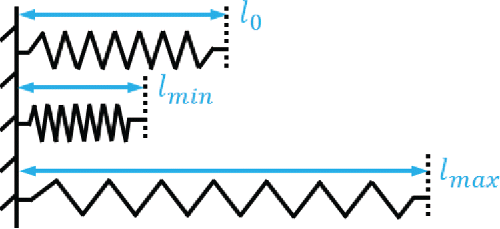
Traditional ChainMail method, such as the 3D ChainMail and the Generalized ChainMail, employs ChainMail bounding regions (CBRs) to regulate the movements of chain elements in the object.Citation11,13As illustrated in , chain element is moved to
while
is moved to
. The
for chain element
with respect to (w.r.t) the new position
of chain element
in the Generalized ChainMail is given by Eq. (Equation1
(1)
(1) ).
Proposed TSVE-ChainMail
A new ChainMail method named the TSVE-ChainMail, time-saving volume-energy conserved ChainMail, is presented. The TSVE-ChainMail can handle various material properties, improve computational efficiency for isotropic materials, and conserve objects' volume and strain energy.
New ChainMail bounding region
The limits and
of the new
in the proposed TSVE-ChainMail are defined as
(3)
(3) where
and
are material parameters of chain elements
and
, and they are corresponded to the spring stiffness
. For isotropic materials (
, Eq. (Equation3
(3)
(3) ) may be simplified to
(4)
(4)
Anisotropic and heterogeneous materials can be modeled by setting different parameters in different directions and regions respectively, which was unable to achieve with the traditional ChainMail.
Time saving scheme for isotropic materials
A time saving scheme (TSS) is developed for isotropic materials of constant material parameter , where each chain element is considered only once in every iteration, leading to improved computational efficiency. Consider the 3 general cases of chain elements' movement illustrated in : Case (1) Following
's movement to
,
and
are moved to
and
respectively (). Then
and
stay within their respective CBRs; Case (2) Following
's movement to
,
is moved to
(). Then
and
stay within their respective CBRs; Case (3) In addition to
,
,
and
's movements,
is moved to
following
's movement to
, whereas
is moved to
following
's movement (). Then
and
stay within their respective CBRs.
Figure 3. The chain element is moved to
(blue arrow) while others follow its movement; the rest state is shown in black and the new positions are shown in red; the solid line indicates that the 2 elements are connected and one is moved directly w.r.t the other, whereas the dotted line indicates that the elements are connected but one is not moved w.r.t the other.

[Proof of Case (1)] Case (1) will be verified if stays within the
w.r.t
, and
stays within the
w.r.t
. Since the exact positions of
and
are unknown, the maximum and minimum limits (2 limits),
and
, are used for the verification of Case (1). Denote the
at the 2 limits of
by
. Thus,
(5)
(5)
Substituting into the lower limit
yields
(6)
(6)
Using the geometric distance , Eq. (Equation6
(6)
(6) ) may be simplified to
(7)
(7)
A similar calculation can be made for ,
,
, and for
. Therefore, it is demonstrated that
stays within the
w.r.t
, and vice versa.
[Proof of Case (2)] Case (2) will be verified if stays within the
w.r.t
, and
stays within the
w.r.t
. Denote the
at the 2 limits of
by
. Thus,
(8)
(8)
Considering the lower limit Substituting
by
from Eq. (Equation7
(7)
(7) ) yields
(9)
(9)
Using the geometric distance, Eq. (Equation9(9)
(9) ) may be simplified to
(10)
(10)
Based on Eqs. (Equation1(1)
(1) ) and (Equation7
(7)
(7) ),
and
. At the lower limit of
,
,
(11)
(11)
A similar calculation can be made for the other boundary limits, and for . Therefore, it is demonstrated that
stays within the
w.r.t
, and vice versa.
[Proof of Case (3)] Case (3) will be verified if stays within the
w.r.t
, and
stays within the
w.r.t
. Denote the
at the 2 limits of
by
. Thus,
(12)
(12)
Substituting in the lower limit given by Eq. (Equation11
(11)
(11) )
(13)
(13)
Similar to in Eq. (Equation11
(11)
(11) ),
. At lower limit of
,
. Thus,
(14)
(14)
A similar calculation can be made for the other boundary limits, and for . Therefore, it is demonstrated that
stays within the
w.r.t
, and vice versa. From the above, we can draw the following 3 remarks. For any 3 neighboring elements A, B and C,
[Remark 1] if A and B are moved w.r.t C, then A and B stay within their respective CBRs (,
and
in ).
[Remark 2] if only A is moved w.r.t C while B and C have been previously moved as per Remark 1, then A and B stay within their respective CBRs (,
and
in ).
[Remark 3] if A and C as well as B and C have been previously moved as per Remark 2, then A and B stay within their respective CBRs (,
and
in ).
The three remarks demonstrate that the chain elements always satisfy the CBRs w.r.t each other in isotropic materials. Hence, each chain element can be considered only once at each iteration, saving the computational time. It should be noted that boundary conditions can be enforced by specifying displacement values to chain elements at the boundary of the calculation domain.
Volume and strain energy conservation
Since most biological soft tissues are incompressible and there is a change in strain energy when a soft object is deformed by an external force, the conservation of volume and strain energy are introduced for accurate soft tissue simulation by adding an additional position adjustment .Citation15 This position adjustment is derived based on the conditions of conservation of volume and energy.Citation16,17
(15)
(15)
(16)
(16)
(17)
(17) where
are the vertices of a tetrahedron,
and
are the inverse of masses of respective chain elements,
is the volume of the tetrahedron at rest state,
is the barycenter of the tetrahedron,
and
are the current and the rest length of
, and
is the stiffness of chain element
.
Implementation results and evaluations
A prototype surgery simulation system has been implemented with the proposed TSVE-ChainMail. Experiments have been conducted to evaluate the performance of the proposed method in terms of soft tissue material properties, computational time, volume conservation and strain energy conservation.
illustrates the deformation of isotropic, anisotropic and heterogeneous materials. The cubic model was deformed evenly for an isotropic material in , deformed more significantly in one direction than the others in , and deformed differently at different regions in .
The computational performance was evaluated on an Intel(R) Core(TM) i7-4700 [email protected] PC. Experiments were conducted under the same conditions to compare the timing performances with and without the use of TSS for isotropic materials. As illustrated in , the computational time with TSS was less than that without TSS for isotropic materials. A computational gain of 29.4% has been achieved for the real-time visual refresh rate (30Hz) in terms of the number of moving chain elements. The volume conservation has been achieved with the proposed ChainMail. As shown in , the proposed ChainMail conserved the object's volume considerably better than the traditional ChainMail, which had a significant volume loss after deformation. The volume change after deformation was 0.71% for the TSVE-ChainMail whereas it was 14.31% for the traditional ChainMail.
Interactive deformation of virtual human organs with force feedback has been achieved with the proposed method. illustrates the deformation process of a volumetric kidney model with a virtual probe. The strain energy conservation is presented in : the kidney model returned to its original state with the proposed ChainMail whereas the traditional ChainMail failed to do so. It was also noticed that a significant visual improvement has been achieved with the proposed method.
Conclusion
This paper presents a time-saving volume-energy conserved ChainMail method for real-time soft tissue simulation. This method allows different materials to be assigned to different chain elements to handle various material behaviors. A time-saving scheme is developed to improve computational efficiency for isotropic materials, and volume and strain energy conservation are proposed for realistic soft tissue deformation. Results demonstrate that the proposed method cannot only handle isotropic, anisotropic and heterogeneous materials but also model soft tissues' incompressibility and relaxation behaviors. The achieved performance is outperformed than that of the traditional ChainMail. Future research work will focus on extending the proposed method to model complex surgical operations.
Disclosure of Potential Conflicts of Interest
No potential conflicts of interest were disclosed.
References
- Miller K. Computational Biomechanics for Patient-Specific Applications. Ann Biomed Eng 2016; 44:1-2; PMID:26620776; http://dx.doi.org/10.1007/s10439-015-1519-9.
- Duan Y, Huang W, Chang H, Chen W, Zhou J, Teo SK, Su Y, Chui CK, Chang S. Volume Preserved Mass-Spring Model with Novel Constraints for Soft Tissue Deformation. IEEE J Biomed Health Inform 2016; 20:268-80; PMID:25398184; http://dx.doi.org/10.1109/JBHI.2014.2370059.
- Freutel M, Schmidt H, Durselen L, Ignatius A, Galbusera F. Finite element modeling of soft tissues: Material models, tissue interaction and challenges. Clin Biomech 2014; 29:363-72; PMID:24529470; http://dx.doi.org/10.1016/j.clinbiomech.2014.01.006.
- Yang C, Li S, Lan Y, Wang L, Hao A, Qin H. Coupling time-varying modal analysis and FEM for real-time cutting simulation of objects with multi-material sub-domains. Computer Aided Geometric Design 2016; 43:53-67; http://dx.doi.org/10.1016/j.cagd.2016.02.014.
- Wu W, Heng PA. An improved scheme of an interactive finite element model for 3D soft-tissue cutting and deformation. The Visual Computer 2005; 21:707-16; http://dx.doi.org/10.1007/s00371-005-0310-6.
- Miller K, Joldes G, Lance D, Wittek A. Total Lagrangian explicit dynamics finite element algorithm for computing soft tissue deformation. Communications in Numerical Methods in Engineering 2007; 23:121-34; http://dx.doi.org/10.1002/cnm.887.
- Miller K, Wittek A, Joldes G, Horton A, Dutta-Roy T, Berger J, Morriss L. Modelling brain deformations for computer-integrated neurosurgery. International Journal for Numerical Methods in Biomedical Engineering 2010; 26:117-38; http://dx.doi.org/10.1002/cnm.1260.
- Taylor ZA, Cheng M, Ourselin S. High-speed nonlinear finite element analysis for surgical simulation using graphics processing units. IEEE Trans Med Imaging 2008; 27:650-63; PMID:18450538; http://dx.doi.org/10.1109/TMI.2007.913112.
- Faure F, Duriez C, Delingette H, Allard J, Gilles B, Marchesseau S, Talbot H, Courtecuisse H, Bousquet G, Peterlik I, et al. Sofa: A multi-model framework for interactive physical simulation. Soft Tissue Biomechanical Modeling for Computer Assisted Surgery. Springer, 2012:283-321.
- Johnsen SF, Taylor ZA, Clarkson MJ, Hipwell J, Modat M, Eiben B, Han L, Hu Y, Mertzanidou T, Hawkes DJ, et al. NiftySim: A GPU-based nonlinear finite element package for simulation of soft tissue biomechanics. Int J Comput Assisted Radiol Surg 2015; 10:1077-95; PMID:25241111; http://dx.doi.org/10.1007/s11548-014-1118-5.
- Frisken-Gibson SF. 3D ChainMail: a Fast Algorithm for Deforming Volumetric Objects. Proc Symposium on Interactive 3D graphics 1997:149-54.
- Frisken-Gibson SF. Using linked volumes to model object collisions, deformation, cutting, carving, and joining. IEEE Transactions on Visualization and Computer Graphics 1999; 5:333-48; http://dx.doi.org/10.1109/2945.817350.
- Li Y, Brodlie K. Soft Object Modelling with Generalised ChainMail - Extending the Boundaries of Web-based Graphics. Comput Graph Forum 2003; 22:717-27; http://dx.doi.org/10.1111/j.1467-8659.2003.00719.x.
- Rodriguez A, Leon A, Arroyo G, Mantas JM. SP-ChainMail: a GPU-based sparse parallel ChainMail algorithm for deforming medical volumes. J Supercomput 2015; 71:3482-99; http://dx.doi.org/10.1007/s11227-015-1445-5.
- Fung Y-C. Biomechanics: Mechanical Properties of Living Tissues. Springer-Verlag, 1993.
- Bender J, Müller M, Otaduy MA, Teschner M, Macklin M. A Survey on Position-Based Simulation Methods in Computer Graphics. Comput Graph Forum 2014; 33:228-51; http://dx.doi.org/10.1111/cgf.12346.
- Pan J, Bai J, Zhao X, Hao A, Qin H. Real-time haptic manipulation and cutting of hybrid soft tissue models by extended position-based dynamics. Computer Animation and Virtual Worlds 2015; 26:321-35; http://dx.doi.org/10.1002/cav.1655.

